 Facebook
Facebook
 X
X
 Instagram
Instagram
 TikTok
TikTok
 Youtube
Youtube
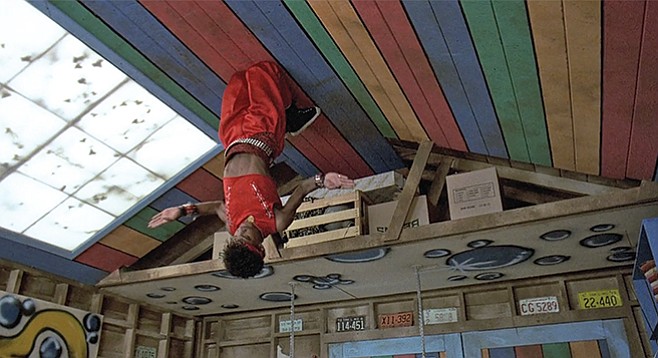
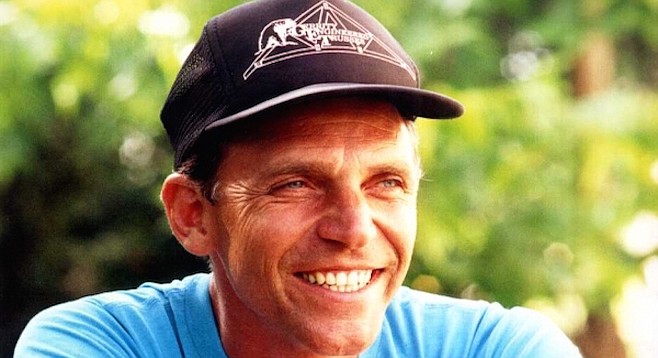
Across the room at Cinema Society gansamacher Andy Friedenberg’s 60th birthday party stood Saundra Saperstein, Chair of the San Diego Jewish Film Festival. When asked what celebrities would be attending SDJFF 23, she mentioned Theodore Bikel — so memorable in Taxi Driver — and someone named Shmulik Firstenberg.
My Uncle Sam’s Hebrew name was Shmuel, but the chances of cultured Saundra having any knowledge of Sam Firstenberg, whose Ninja III: The Domination and Breakin’ 2: Electric Boogaloo, purveyor of fine fodder for the Cannon Group canon, seemed remote. Saundra not only knew Sam, she invited him to introduce The Go-Go Boys: The Inside Story of Cannon Films when it plays this year’s festival.
You’ll have two chances to catch this delightful time trip through the bowels of ’80s cinema — 4:30 p.m. on Sunday, February 8, at Edwards San Marcos and 4:30 p.m. on Sunday, February 15, at Reading Cinema’s Clairemont Town Square. Mr. Firstenberg will in attendance for both screenings. For more information on this and the 49 other features and 50 shorts to be showcased, visit sdcjc.org/sdjff.
This small portion of the interview pertains strictly to the history of, and Sam’s involvement with, a nascent Cannon Films.
Scott Marks: How is it that Saundra Saperstein was able to snag you for this year’s Jewish Film Festival?
Sam Firstenberg: When I made my first film for Cannon, Revenge of the Ninja with Shô Kosugi, we were looking for locations. Saundra was the head, or something, of the Utah Film Commission. One of the locations we considered was Salt Lake City. Saundra showed us the city and we discussed the possibilities. We wound up shooting there because it fit the location we needed. Yom Kippur fell during pre-production and she took us to a Salt Lake City synagogue, which in itself was an experience.
SM: It’s a city not known for playing home to a burgeoning Jewish population.
SF: Exactly. All of the different types of Jews — reformed, orthodox, etc. — all congregated in one place. And it looks like a church. (Laughing.) There’s organ music! There was a group of Israelis — Cannon itself was from Israel. The cameraman, the grip, the makeup man...a bunch of us were from Israel. She took care of us. We kind of kept in touch, but had lost touch after 30 years. Suddenly I get this letter from her asking if I would come and help out with the Go-Go film. She knew of my contacts with Golan & Globus and Cannon Films.
SM: Did you have any contact with Hilla Medalia while she was directing the film?
SF: I knew her before Cannon. I worked with her even before there was Cannon. Hilla mainly interviewed people in Israel and I’m here in Los Angeles. We were in contact, but somehow our schedules never worked out and she did not interview me for the movie.
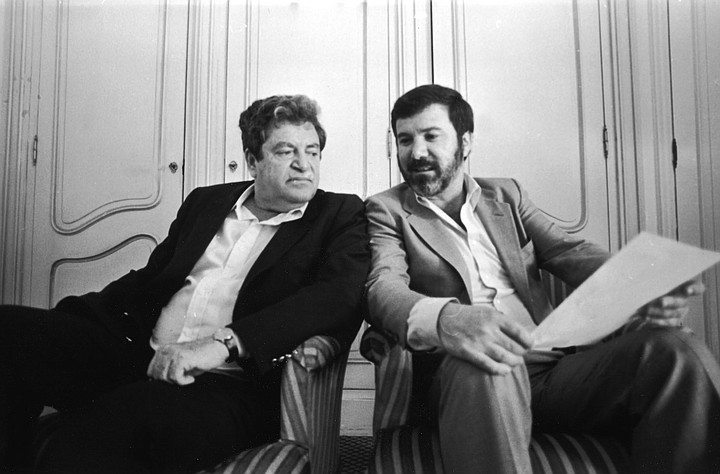
SM: Do you remember the first time you encountered Menahem Golan and Yoram Globus?
SF: Absolutely. I came to Los Angeles in 1972 to study film. At the time it was not very customary because an Israeli who wanted to study film generally went to England or to France. Nobody went to Hollywood. Hollywood was beneath us. We were artists! We made films like Fellini, not Hollywood movies. (Laughing.)
I landed a job at Channel 13 here in Los Angeles. At the end of 1972, I was invited to a Hanukkah party. The host told me that Menahem Golan would be at the party. He had just finished selling the movie Kazablan to one of the majors. We started to talk, and he told me he was producing a movie here, Lepke, starring Tony Curtis. In my childhood I knew the name Menahem Golan. Everybody knew the name! He was the moviemaker in Israel. I expressed a desire to come and work with him. The first question: “How much do you want?” (Laughing.) I didn’t want money. I just wanted to work. “You’re hired,” he said. “Come to Culver City first thing Monday morning.” And that was it.
The name of the company at the time was Ameri-Euro Pictures. It was before Cannon. So my first picture was Lepke. They gave me the job of schlepper. I ran around getting coffee and setting up chairs. Whatever needed to be done.
SM: When did it first dawn on you that these guys were the McDonalds of Hollywood film producers?
SF (Laughing): When Lepke finished, I continued with them, working in the office as a runner. The little office on the 20th Century Fox lot consisted of four people: Menahem Golan, Yoram Globus, their secretary, and me. Not knowing whether they’d make it in Hollywood, at that point all they had was aspiration. They had good dreams. Lepke, a film about the Jewish mafia, was not entirely a bad movie. At least the intention was to treat it like a major movie.
There were a lot of big plans and I was running around with scripts. I delivered a script for The Magician of Lublin to Dustin Hoffman. They moved back to Israel and made Israeli and American movies. I worked with them in Israel as an assistant director on many productions. These weren’t small budget films. I made enough money as an assistant director on Operation Thunderbolt to buy an apartment. It was quite a big movie.
I decided to come back to Los Angeles and attend graduate school at Loyola Marymount. I directed a feature movie, One More Chance, while in school. I didn’t know what to do with the film once I had finished it. By then, Golan & Globas had purchased the distribution company Cannon Films and moved back to New York, where it was originally located. They bought it and immediately moved to Los Angeles. I brought the movie to them, they liked it, and took it from me for distribution.
This was 1979 or 1980 when they bought Cannon and turned it into the McDonalds of Hollywood. They started with three or four horror pictures and immediately moved to action. They quickly realized that they didn’t understand horror. They turned out one low-budget feature after another. Like a machine.
SM: Golan & Globus would assign you sequels of established commodities — Enter the Ninja, Breakin’, Delta Force — and each time you hit it out of the park by outdoing the original. Would it be fair to refer to you as the Cannon Films cleanup batter?
SF (Laughing): Sure.
SM: For the most part, threequels are shit made so that the cast and crew can line their pockets with “f.u.” money. The virtues of your sequels and threequels is they are so well made, funny, and free or camp and irony. You have the courage of your convictions to play this stuff straight. Essentially you were directing sequels to films you probably otherwise wouldn’t have seen in the first place. At gunpoint.
SF: Absolutely!
SM: I’m fascinated by one of the concepts posed in the film: the Israeli-born team saw movies as a way of assimilating with American audiences. Did you experience similar feelings?
SF: Yes. Menahem went to school here years before me. Take my love for American movies and multiply it by ten and you’ll have Menahem. He worked as an assistant to Roger Corman in the 1960s. The movies he made in Israel were all imitations of Hollywood movies. He wasn’t trying to do any movies with a European accent. Both of them wanted to make American movies that would sell all over the world. They wanted to become moguls. The motto of the company was, “Let’s assimilate!” They wanted to pass for Americans so nobody thinks they are anything else but from Hollywood.
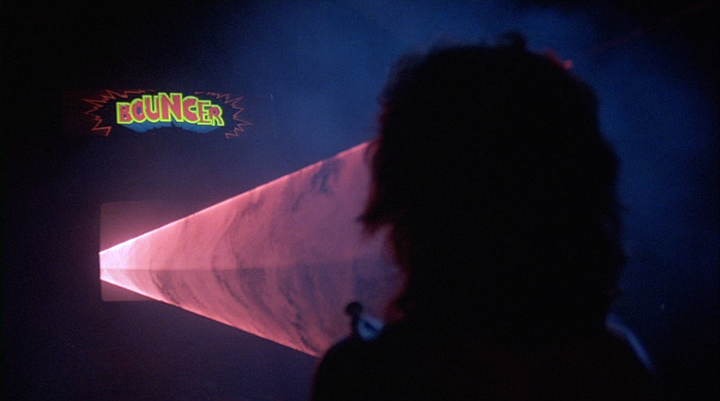
SM: Revenge of the Ninja is a fairly traditional take on the ninja legend, but Ninja III was something quite unexpected. In the Pantheon of horror queens, Lucinda Dickey is your Linda Blair and you wound up making, for lack of a better term, a feminist ninja picture.
SF: When Revenge of the Ninja came into my hands, there were no ninja Westerns. There were a couple of martial arts movies before...Chuck Norris…Octagon...whatever. This type of movies was the business of Hong Kong. First they made Enter the Ninja with Franco Nero, and it was a modest success. I was approached for the sequel and was familiar with Kurosawa’s samurai films, not martial arts movies. I met Shô Kosugi and he introduced me to this gene of traditional Hong Kong martial arts movies. My intention was not to make another Hong Kong movie filled with martial arts, my intention was to make a Western action movie. The action scenes were martial arts, mixed with guns and cars and chases.
SM: And for the next one you up the stakes by throwing in a little Flashdance and a little Exorcist...
SF: Now comes Ninja III. The dominant movie at the time was Tobe Hooper’s Poltergeist. The idea of having a female lead rather than Shô Kosugi was Menahem Golan’s, not mine. He said, “Let’s do this one with a female.” Great. How do we do a female ninja? The idea sprang to our minds: she would be possessed by a ninja!
SM: And a mind-numbing video game that violently interferes with the thought patterns of its users. How prophetic were you?
SF (Laughing): I don’t know who had this exact idea. When you make this type of movie, you cannot take it seriously.
SM: Forgive me, I disagree. Part of what makes these films such a joy to watch is that you do take them seriously, with a straight face and a tremendous amount of conviction.
SF: No irony. But if I can analyze it years after making the movie, there is this overall feeling of a fairyland, a place where video games can possess their players. We played it straight but not seriously.
SM: There you go!
SF: We played it as if it were real life.
SM: You are one of the few Jews to have made a living off of breakdancing.
SF (Laughing): Sometime I meet African Americans and we get to talking, and I say, “I directed (Breakin’ 2).” And he or she will look at me and say, “C’mon! It’s impossible.” He saw the movie and knew for a fact that it it was directed by a black director.
SM: Whose idea was it to pattern Breakin 2 after an MGM musical?
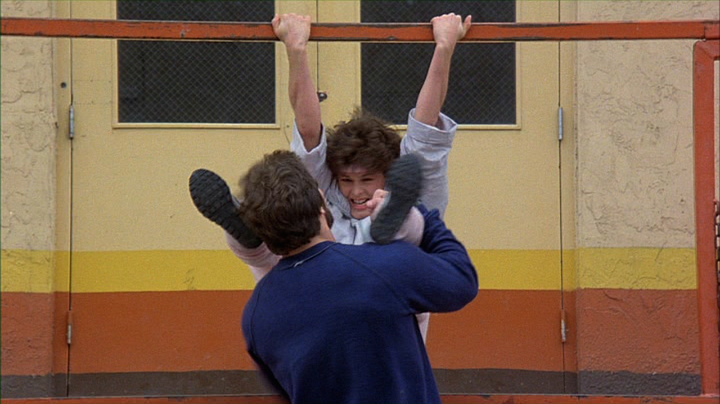
SF: First they made Breakin’. I was not involved at all except that I gave them Lucinda Dickey after...the real events of production are that she made Ninja III first. Then she went to do Breakin’. Because she was a dancer. For some reason, when they came to do the sequel they did not hire the original director [Joel Silberg]. I don’t know what happened or why. They turned to me. We had just finished the editing on Ninja III and now Breakin’ 2 was in my hands. I am a product of Hollywood films from childhood. Westerns, crime movies, musicals — I was a genre kid. In my neighborhood theatre that’s what they played. Once we started...again, I don’t come from a line of breakdancers. I didn’t come from the hip-hop culture.
SM: I’m shocked to hear you admit that.
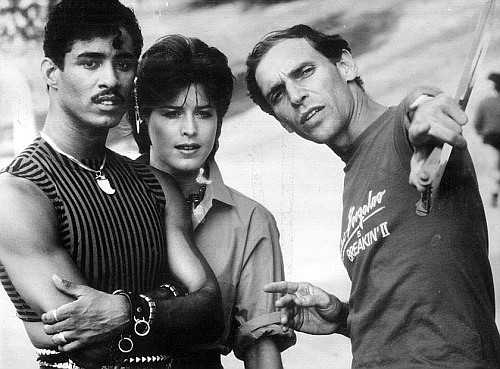
SF (Laughing): Despite the fact that Shabba Doo gave me a street name. My street name was “Shmool the Cool.” Some directors, even in the martial arts movies, are trying to be purists. And here I am making a Western movie. The same thing happened with Breakin’ 2. If the director had come from a hip-hop culture, he or she would have been very adherent to the culture and the dances, etc. I came from Hollywood musical and wanted to make one. Either consciously or subconsciously we made it more and more like a classic Hollywood musical. Then came the dancing-around-the room number, which is really Fred Astaire.
SM: Royal Wedding. You do up the ante a bit by having your version of Sarah Churchill enter the scene. That was quite a lovely touch.
SF: I’m so glad that you noticed it, because technically it was quite challenging. She was upside-down and he was upside-right. We had to hold her hair down with glue. It was my idea to bring her in at the last minute. I wanted to end this upside-down gimmick on a strange note.
SM: People dump on Cannon films, and in many cases rightfully so, but these two movies are the closest Golan & Globus came to capturing the spirit of Roger Corman’s New World Pictures. What do you see as Go-Go’s blueprint for success? What advice were you given before undertaking each picture?
SF: The biggest success for me was actually American Ninja. The movie made more than $100 million. The secret to Cannon was one man: Menahem Golan. Behind him there was an operation and money, of course. The same with Roger Corman. They’re the same type of people. They eat ideas and stories for breakfast. I was pretty free while making the movies. We would have a meeting or two during pre-production to go over the script. Once I was on location, he left me free to direct. He was very involved in the editing room during post-production. He would come every week, sit in the editing room with me, come up with a couple of suggestions….
I must give him credit. The original ending to Ninja III didn’t work. He recognized it immediately and said, “You’re absolutely right. Let’s shoot another ending.” Another producer, more interested in money, would have gone with what we had. Storytelling was in [Golan’s] blood. This was the secret. He was very charming. He got [John] Cassavetes to work for him! This came out of the charm. He would sit Cassavetes and the conversation would be what Cassavetes wanted to talk about. Not about money or budget! Whatever it took to engage him. It was the same thing with Roger Corman, except Corman was more of an intellect.
SM: There’s a scene in Go-Go Boys where Golan has difficulty admitting to failure. Why do you think that is?
SF: It had to do with his ego. He had a huge ego. Even though Yoram Globus admits that they failed, Golan cannot admit that anything went wrong. For him, everything was fantastic. Towards the end, things went terrible, but in his fantastic mind, nothing was wrong. Certainly not because of him. It was other people’s fault.
SM: Do you still exchange Christmas cards with Shabba-Doo and Boogaloo Shrimp?
SF (Laughing): E-mails.
SM: Can we expect a new Sam Firstenberg film anytime soon?
SF: I don’t know. In Hollywood they pigeonhole you. Our movies, the types of movies that we made, were medium budget. The medium budget movie has disappeared totally. The base for this was the home video market, which disappeared completely. Today a director can enter the multi-million dollar huge action movie, or they will ask them to make a small movie based on the economics of cinema today. You’d have five weeks and less than $1 million to make something like Ninja III. It’s impossible.



Across the room at Cinema Society gansamacher Andy Friedenberg’s 60th birthday party stood Saundra Saperstein, Chair of the San Diego Jewish Film Festival. When asked what celebrities would be attending SDJFF 23, she mentioned Theodore Bikel — so memorable in Taxi Driver — and someone named Shmulik Firstenberg.
My Uncle Sam’s Hebrew name was Shmuel, but the chances of cultured Saundra having any knowledge of Sam Firstenberg, whose Ninja III: The Domination and Breakin’ 2: Electric Boogaloo, purveyor of fine fodder for the Cannon Group canon, seemed remote. Saundra not only knew Sam, she invited him to introduce The Go-Go Boys: The Inside Story of Cannon Films when it plays this year’s festival.
You’ll have two chances to catch this delightful time trip through the bowels of ’80s cinema — 4:30 p.m. on Sunday, February 8, at Edwards San Marcos and 4:30 p.m. on Sunday, February 15, at Reading Cinema’s Clairemont Town Square. Mr. Firstenberg will in attendance for both screenings. For more information on this and the 49 other features and 50 shorts to be showcased, visit sdcjc.org/sdjff.
This small portion of the interview pertains strictly to the history of, and Sam’s involvement with, a nascent Cannon Films.
Scott Marks: How is it that Saundra Saperstein was able to snag you for this year’s Jewish Film Festival?
Sam Firstenberg: When I made my first film for Cannon, Revenge of the Ninja with Shô Kosugi, we were looking for locations. Saundra was the head, or something, of the Utah Film Commission. One of the locations we considered was Salt Lake City. Saundra showed us the city and we discussed the possibilities. We wound up shooting there because it fit the location we needed. Yom Kippur fell during pre-production and she took us to a Salt Lake City synagogue, which in itself was an experience.
SM: It’s a city not known for playing home to a burgeoning Jewish population.
SF: Exactly. All of the different types of Jews — reformed, orthodox, etc. — all congregated in one place. And it looks like a church. (Laughing.) There’s organ music! There was a group of Israelis — Cannon itself was from Israel. The cameraman, the grip, the makeup man...a bunch of us were from Israel. She took care of us. We kind of kept in touch, but had lost touch after 30 years. Suddenly I get this letter from her asking if I would come and help out with the Go-Go film. She knew of my contacts with Golan & Globus and Cannon Films.
SM: Did you have any contact with Hilla Medalia while she was directing the film?
SF: I knew her before Cannon. I worked with her even before there was Cannon. Hilla mainly interviewed people in Israel and I’m here in Los Angeles. We were in contact, but somehow our schedules never worked out and she did not interview me for the movie.

SM: Do you remember the first time you encountered Menahem Golan and Yoram Globus?
SF: Absolutely. I came to Los Angeles in 1972 to study film. At the time it was not very customary because an Israeli who wanted to study film generally went to England or to France. Nobody went to Hollywood. Hollywood was beneath us. We were artists! We made films like Fellini, not Hollywood movies. (Laughing.)
I landed a job at Channel 13 here in Los Angeles. At the end of 1972, I was invited to a Hanukkah party. The host told me that Menahem Golan would be at the party. He had just finished selling the movie Kazablan to one of the majors. We started to talk, and he told me he was producing a movie here, Lepke, starring Tony Curtis. In my childhood I knew the name Menahem Golan. Everybody knew the name! He was the moviemaker in Israel. I expressed a desire to come and work with him. The first question: “How much do you want?” (Laughing.) I didn’t want money. I just wanted to work. “You’re hired,” he said. “Come to Culver City first thing Monday morning.” And that was it.
The name of the company at the time was Ameri-Euro Pictures. It was before Cannon. So my first picture was Lepke. They gave me the job of schlepper. I ran around getting coffee and setting up chairs. Whatever needed to be done.
SM: When did it first dawn on you that these guys were the McDonalds of Hollywood film producers?
SF (Laughing): When Lepke finished, I continued with them, working in the office as a runner. The little office on the 20th Century Fox lot consisted of four people: Menahem Golan, Yoram Globus, their secretary, and me. Not knowing whether they’d make it in Hollywood, at that point all they had was aspiration. They had good dreams. Lepke, a film about the Jewish mafia, was not entirely a bad movie. At least the intention was to treat it like a major movie.
There were a lot of big plans and I was running around with scripts. I delivered a script for The Magician of Lublin to Dustin Hoffman. They moved back to Israel and made Israeli and American movies. I worked with them in Israel as an assistant director on many productions. These weren’t small budget films. I made enough money as an assistant director on Operation Thunderbolt to buy an apartment. It was quite a big movie.
I decided to come back to Los Angeles and attend graduate school at Loyola Marymount. I directed a feature movie, One More Chance, while in school. I didn’t know what to do with the film once I had finished it. By then, Golan & Globas had purchased the distribution company Cannon Films and moved back to New York, where it was originally located. They bought it and immediately moved to Los Angeles. I brought the movie to them, they liked it, and took it from me for distribution.
This was 1979 or 1980 when they bought Cannon and turned it into the McDonalds of Hollywood. They started with three or four horror pictures and immediately moved to action. They quickly realized that they didn’t understand horror. They turned out one low-budget feature after another. Like a machine.
SM: Golan & Globus would assign you sequels of established commodities — Enter the Ninja, Breakin’, Delta Force — and each time you hit it out of the park by outdoing the original. Would it be fair to refer to you as the Cannon Films cleanup batter?
SF (Laughing): Sure.
SM: For the most part, threequels are shit made so that the cast and crew can line their pockets with “f.u.” money. The virtues of your sequels and threequels is they are so well made, funny, and free or camp and irony. You have the courage of your convictions to play this stuff straight. Essentially you were directing sequels to films you probably otherwise wouldn’t have seen in the first place. At gunpoint.
SF: Absolutely!
SM: I’m fascinated by one of the concepts posed in the film: the Israeli-born team saw movies as a way of assimilating with American audiences. Did you experience similar feelings?
SF: Yes. Menahem went to school here years before me. Take my love for American movies and multiply it by ten and you’ll have Menahem. He worked as an assistant to Roger Corman in the 1960s. The movies he made in Israel were all imitations of Hollywood movies. He wasn’t trying to do any movies with a European accent. Both of them wanted to make American movies that would sell all over the world. They wanted to become moguls. The motto of the company was, “Let’s assimilate!” They wanted to pass for Americans so nobody thinks they are anything else but from Hollywood.

SM: Revenge of the Ninja is a fairly traditional take on the ninja legend, but Ninja III was something quite unexpected. In the Pantheon of horror queens, Lucinda Dickey is your Linda Blair and you wound up making, for lack of a better term, a feminist ninja picture.
SF: When Revenge of the Ninja came into my hands, there were no ninja Westerns. There were a couple of martial arts movies before...Chuck Norris…Octagon...whatever. This type of movies was the business of Hong Kong. First they made Enter the Ninja with Franco Nero, and it was a modest success. I was approached for the sequel and was familiar with Kurosawa’s samurai films, not martial arts movies. I met Shô Kosugi and he introduced me to this gene of traditional Hong Kong martial arts movies. My intention was not to make another Hong Kong movie filled with martial arts, my intention was to make a Western action movie. The action scenes were martial arts, mixed with guns and cars and chases.
SM: And for the next one you up the stakes by throwing in a little Flashdance and a little Exorcist...
SF: Now comes Ninja III. The dominant movie at the time was Tobe Hooper’s Poltergeist. The idea of having a female lead rather than Shô Kosugi was Menahem Golan’s, not mine. He said, “Let’s do this one with a female.” Great. How do we do a female ninja? The idea sprang to our minds: she would be possessed by a ninja!
SM: And a mind-numbing video game that violently interferes with the thought patterns of its users. How prophetic were you?
SF (Laughing): I don’t know who had this exact idea. When you make this type of movie, you cannot take it seriously.
SM: Forgive me, I disagree. Part of what makes these films such a joy to watch is that you do take them seriously, with a straight face and a tremendous amount of conviction.
SF: No irony. But if I can analyze it years after making the movie, there is this overall feeling of a fairyland, a place where video games can possess their players. We played it straight but not seriously.
SM: There you go!
SF: We played it as if it were real life.
SM: You are one of the few Jews to have made a living off of breakdancing.
SF (Laughing): Sometime I meet African Americans and we get to talking, and I say, “I directed (Breakin’ 2).” And he or she will look at me and say, “C’mon! It’s impossible.” He saw the movie and knew for a fact that it it was directed by a black director.
SM: Whose idea was it to pattern Breakin 2 after an MGM musical?

SF: First they made Breakin’. I was not involved at all except that I gave them Lucinda Dickey after...the real events of production are that she made Ninja III first. Then she went to do Breakin’. Because she was a dancer. For some reason, when they came to do the sequel they did not hire the original director [Joel Silberg]. I don’t know what happened or why. They turned to me. We had just finished the editing on Ninja III and now Breakin’ 2 was in my hands. I am a product of Hollywood films from childhood. Westerns, crime movies, musicals — I was a genre kid. In my neighborhood theatre that’s what they played. Once we started...again, I don’t come from a line of breakdancers. I didn’t come from the hip-hop culture.
SM: I’m shocked to hear you admit that.

SF (Laughing): Despite the fact that Shabba Doo gave me a street name. My street name was “Shmool the Cool.” Some directors, even in the martial arts movies, are trying to be purists. And here I am making a Western movie. The same thing happened with Breakin’ 2. If the director had come from a hip-hop culture, he or she would have been very adherent to the culture and the dances, etc. I came from Hollywood musical and wanted to make one. Either consciously or subconsciously we made it more and more like a classic Hollywood musical. Then came the dancing-around-the room number, which is really Fred Astaire.
SM: Royal Wedding. You do up the ante a bit by having your version of Sarah Churchill enter the scene. That was quite a lovely touch.
SF: I’m so glad that you noticed it, because technically it was quite challenging. She was upside-down and he was upside-right. We had to hold her hair down with glue. It was my idea to bring her in at the last minute. I wanted to end this upside-down gimmick on a strange note.
SM: People dump on Cannon films, and in many cases rightfully so, but these two movies are the closest Golan & Globus came to capturing the spirit of Roger Corman’s New World Pictures. What do you see as Go-Go’s blueprint for success? What advice were you given before undertaking each picture?
SF: The biggest success for me was actually American Ninja. The movie made more than $100 million. The secret to Cannon was one man: Menahem Golan. Behind him there was an operation and money, of course. The same with Roger Corman. They’re the same type of people. They eat ideas and stories for breakfast. I was pretty free while making the movies. We would have a meeting or two during pre-production to go over the script. Once I was on location, he left me free to direct. He was very involved in the editing room during post-production. He would come every week, sit in the editing room with me, come up with a couple of suggestions….
I must give him credit. The original ending to Ninja III didn’t work. He recognized it immediately and said, “You’re absolutely right. Let’s shoot another ending.” Another producer, more interested in money, would have gone with what we had. Storytelling was in [Golan’s] blood. This was the secret. He was very charming. He got [John] Cassavetes to work for him! This came out of the charm. He would sit Cassavetes and the conversation would be what Cassavetes wanted to talk about. Not about money or budget! Whatever it took to engage him. It was the same thing with Roger Corman, except Corman was more of an intellect.
SM: There’s a scene in Go-Go Boys where Golan has difficulty admitting to failure. Why do you think that is?
SF: It had to do with his ego. He had a huge ego. Even though Yoram Globus admits that they failed, Golan cannot admit that anything went wrong. For him, everything was fantastic. Towards the end, things went terrible, but in his fantastic mind, nothing was wrong. Certainly not because of him. It was other people’s fault.
SM: Do you still exchange Christmas cards with Shabba-Doo and Boogaloo Shrimp?
SF (Laughing): E-mails.
SM: Can we expect a new Sam Firstenberg film anytime soon?
SF: I don’t know. In Hollywood they pigeonhole you. Our movies, the types of movies that we made, were medium budget. The medium budget movie has disappeared totally. The base for this was the home video market, which disappeared completely. Today a director can enter the multi-million dollar huge action movie, or they will ask them to make a small movie based on the economics of cinema today. You’d have five weeks and less than $1 million to make something like Ninja III. It’s impossible.
Comments